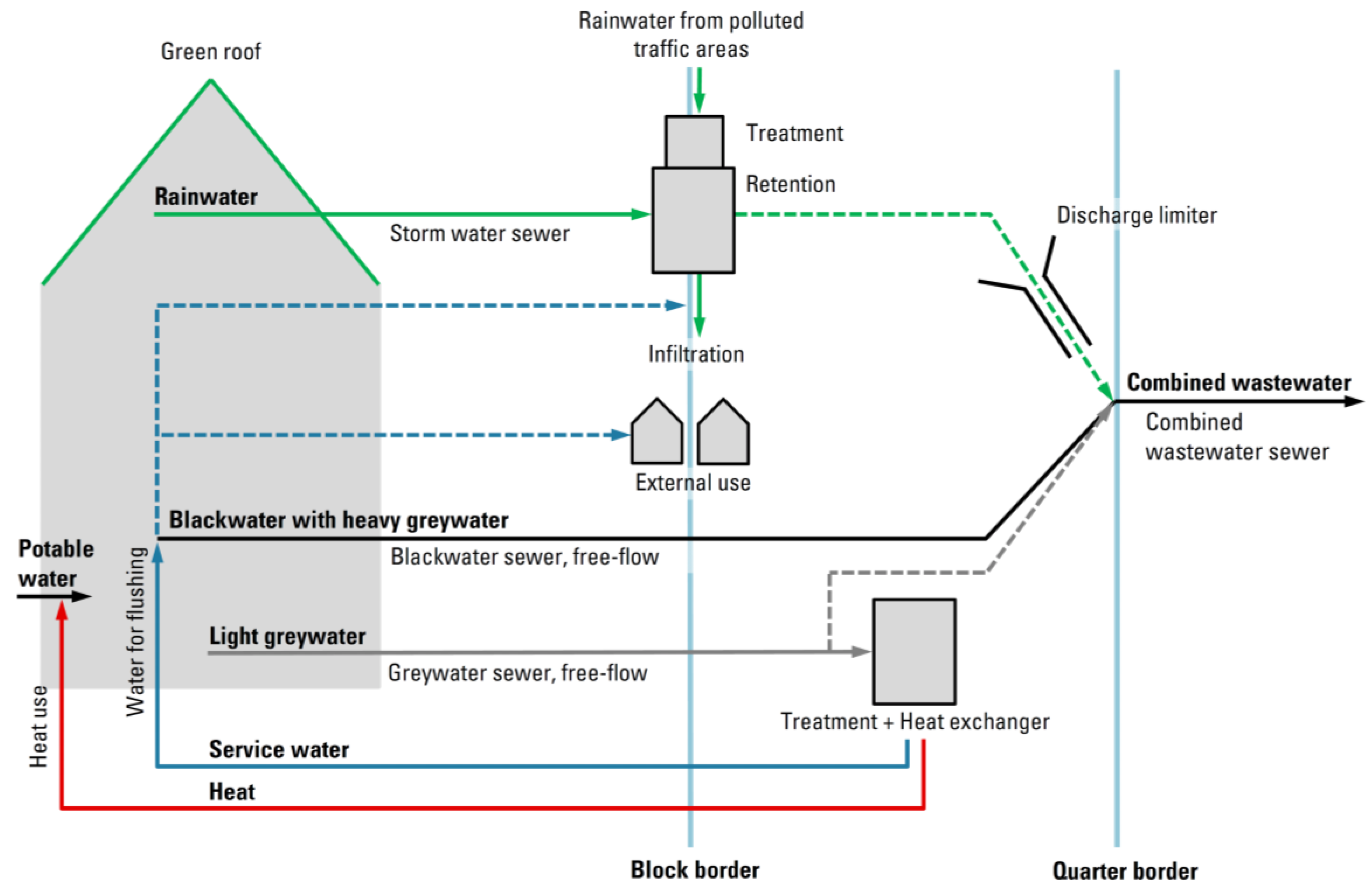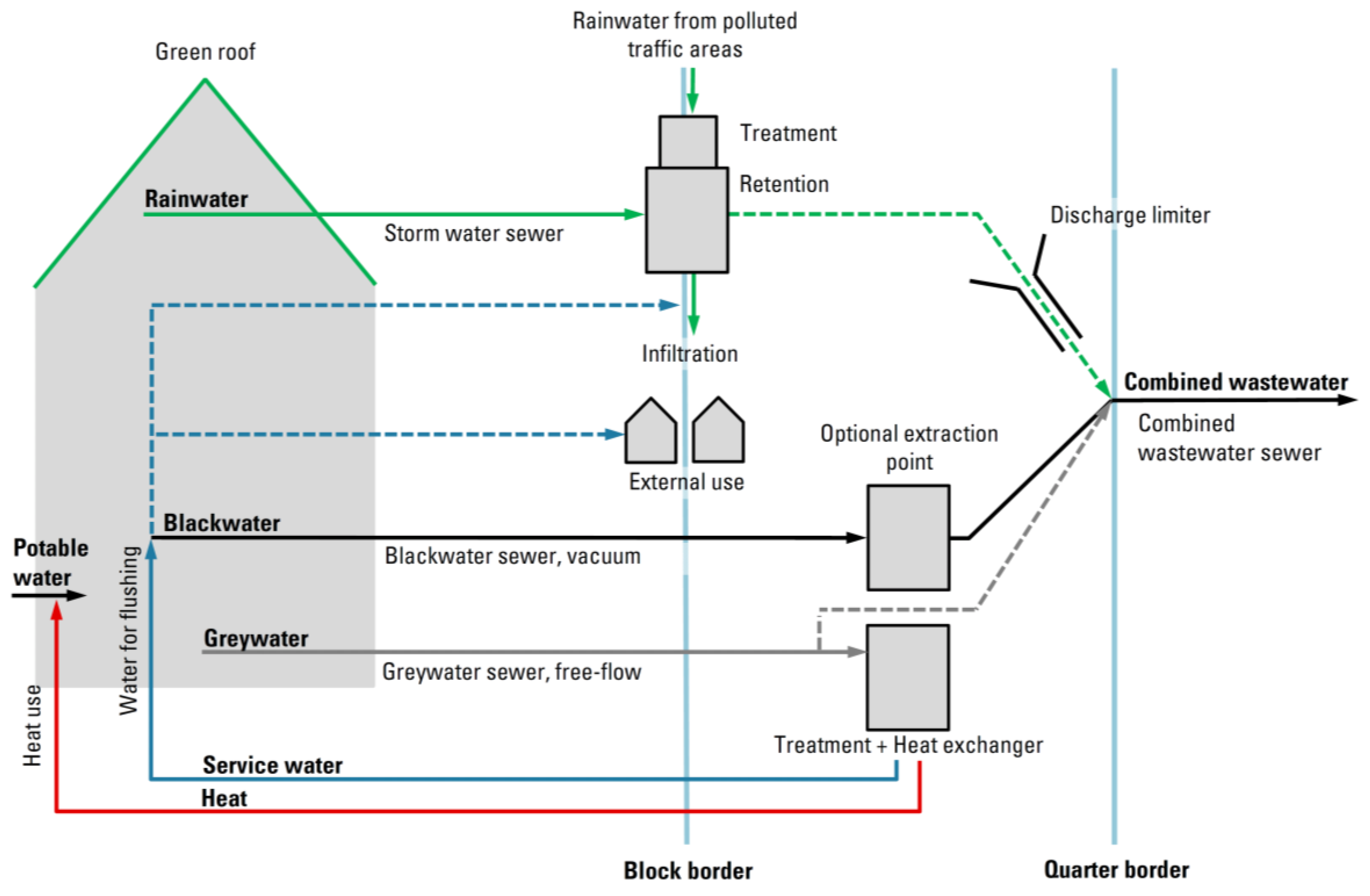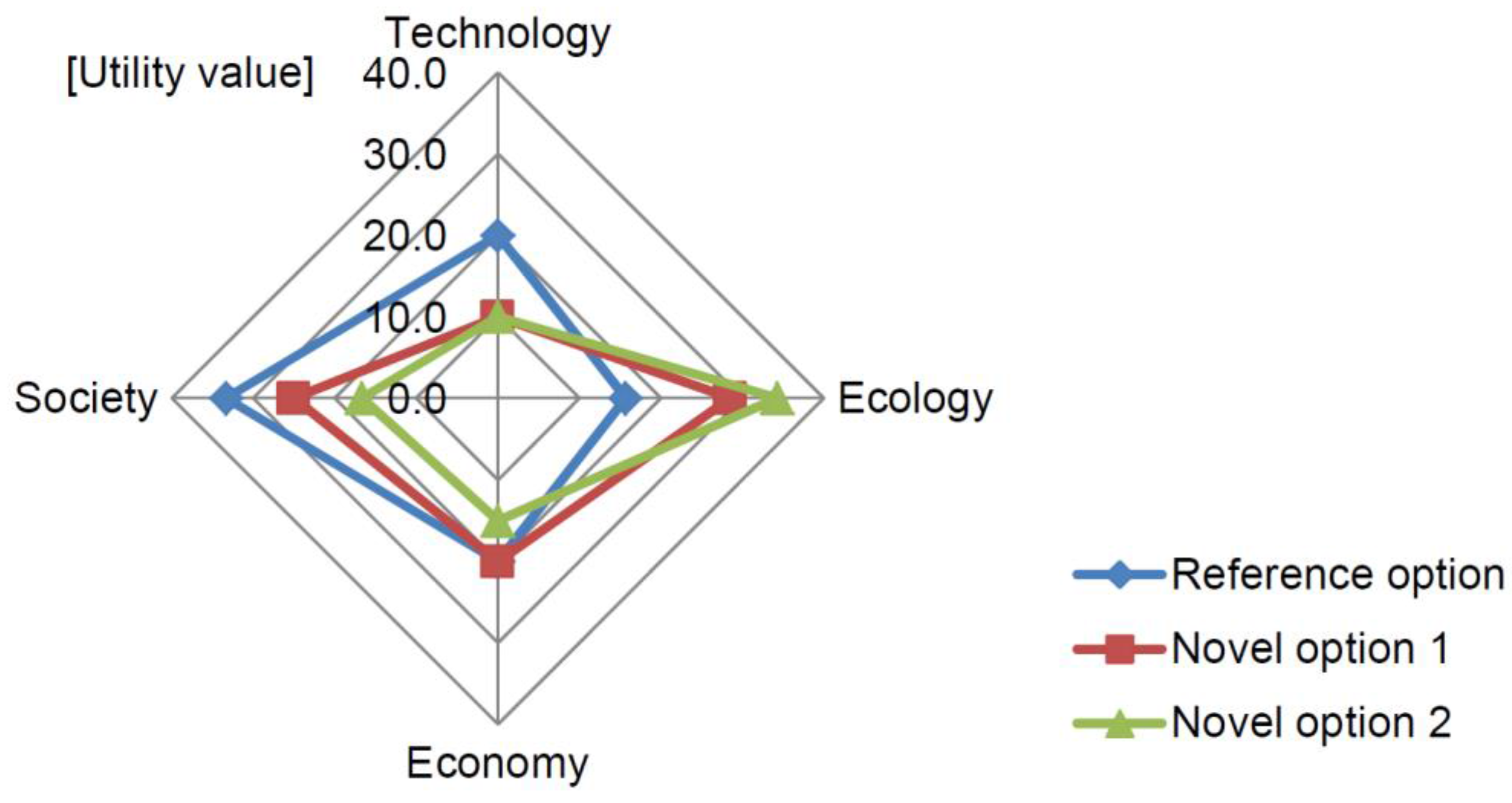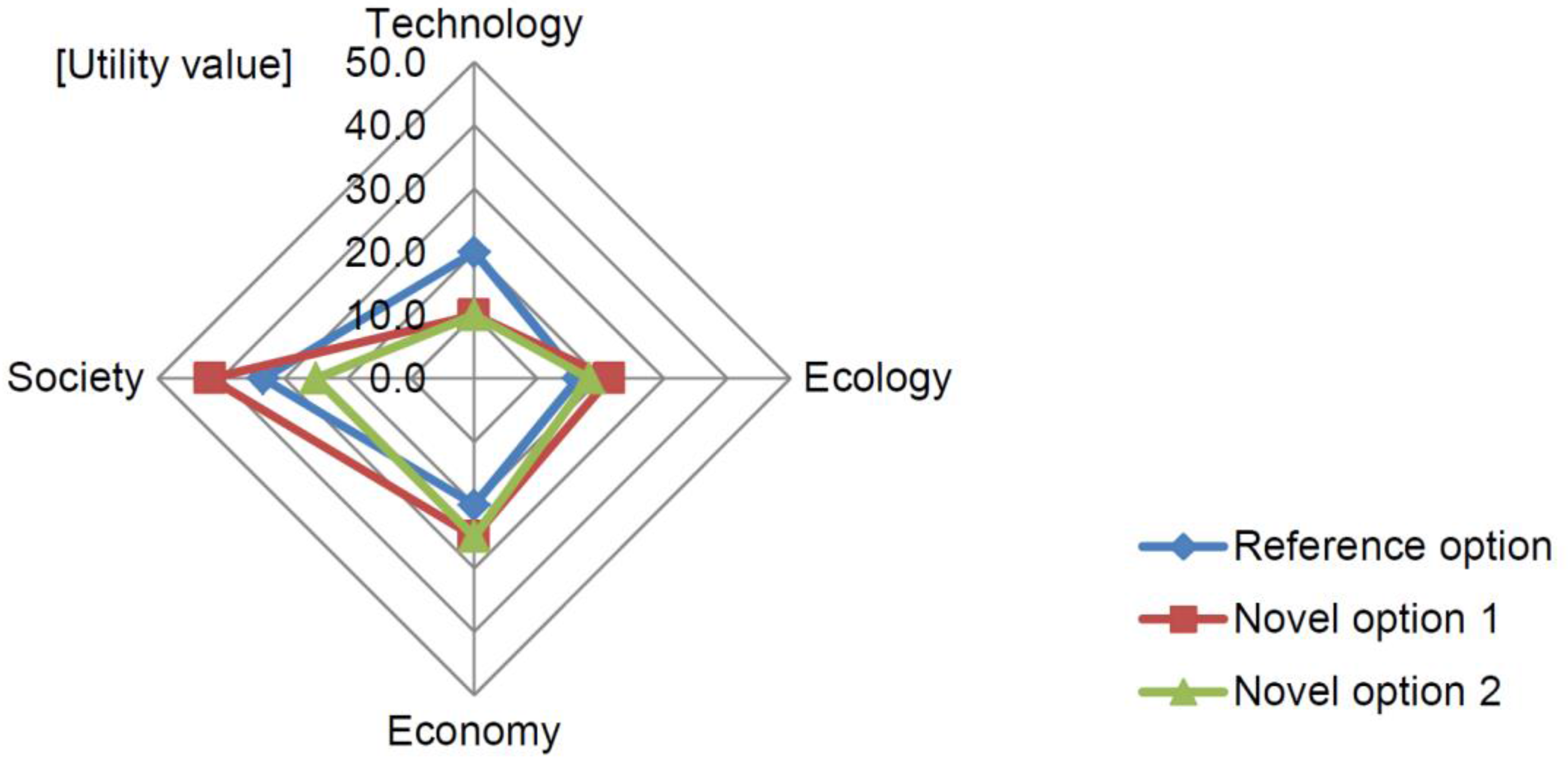Integrated Assessment of Novel Urban Water Infrastructures in Frankfurt am Main and Hamburg, Germany
Abstract
:1. Introduction
2. Materials and Methods
2.1. Case Studies and Technical Options
- conventional wastewater disposal and treatment
- greywater separation, treatment and reuse
- blackwater separation and treatment, possibly by using vacuum sewer systems for blackwater disposal
- heat recovery from wastewater (streams).
2.2. Methodology
2.2.1. Stakeholder Involvement
2.2.2. Multi-Criteria Decision Analysis
2.2.3. Criteria Weighting
2.2.4. System Boundaries and Assessment Goals
3. Results and Discussion
3.1. Assessment Categories and Criteria
3.2. Assessment Results
4. Conclusions
Supplementary Materials
Acknowledgments
Author Contributions
Conflicts of Interest
References
- Hüttl, R.; Bens, O. (Eds.) Georessource Wasser—Herausforderung Globaler Wandel. Beiträge zu Einer Integrierten Wasserressourcenbewirtschaftung in Deutschland (Water as a Geological Resource—Challenge Global Change. Contributions to an Integrated Water Management in Germany); Deutsche Akademie der Technikwissenschaften (acatech): Munich, Germany, 2012. [Google Scholar]
- Hillenbrand, T.; Hiessl, H.; Klug, S.; von Lüninck, B.; Niederste-Hollenberg, J.; Sartorius, C.; Walz, R. Herausforderungen Einer Nachhaltigen Wasserwirtschaft; Innovationsreport (Challenges of a Sustainable Water Management. Innovation Report); Arbeitsbericht 158; Büro für Technikfolgenabschätzung Beim Deutschen Bundestag (TAB): Berlin, Germany, 2013; Available online: https://www.tab-beim-bundestag.de/de/pdf/publikationen/berichte/TAB-Arbeitsbericht-ab158.pdf (accessed on 20 January 2016).
- Schramm, E.; Kluge, T.; Beck, S.; Hansjürgens, B.; Hiessl, H.; Sartorius, C. Integrierte Systemlösungen als Strategie für eine nachhaltige und exportstarke Wasserwirtschaft (Integrated system solutions as strategy for a sustainable water management with export strength). Wasser Abfall 2013, 15, 39–44. [Google Scholar] [CrossRef]
- Hillenbrand, T.; Hiessl, H. Sich ändernde Planungsgrundlagen für Wasserinfrastruktursysteme. Teil 1: Klimawandel, demographischer Wandel, neue ökologische Anforderungen (Changing planning basis for water infrastructure systems. Part 1: Climate change, demographic change, new ecological requirements). KA Wasserwirtsch. Abwasser Abfall 2006, 53, 1265–1271. [Google Scholar]
- Nowak, M.; Guenther, E. Scenario planning: Managing the effects of demographic change on East German wastewater companies. In H2O—Wasser; Ökonomie und Management Einer Schlüsselressource: Berlin, Germany, 2010; pp. 45–63. [Google Scholar]
- Schramm, E.; Kerber, H.; Trapp, J.H.; Zimmermann, M.; Winker, M. Novel urban water systems in Germany: Governance structures under transformation. Urban Water J. 2017, 6, 1–10. [Google Scholar] [CrossRef]
- Moss, T. ‘Cold spots’ of Urban Infrastructure: ‘Shrinking’ Processes in Eastern Germany and the Modern Infrastructural Ideal. Int. J. Urban Reg. Res. 2008, 32, 436–451. [Google Scholar] [CrossRef]
- Wikramanayake, N.; Corea, E.J.H. Alternative Technology for Urban Wastewater Treatment: Case Studies and Issues of Implementation and Sustainability. In Proceedings of the World Water and Environmental Resources Congress, Philadelphia, PA, USA, 23–26 June 2003; Bizier, P., DeBarry, P., Eds.; American Society of Civil Engineers: Reston, VA, USA, 2003. [Google Scholar]
- Daigger, G. Wastewater management in the 21st century. J. Environ. Eng. 2007, 11, 671–680. [Google Scholar] [CrossRef]
- Deutsche Vereinigung für Wasserwirtschaft, Abwasser und Abfall e.V. (DWA). Neuartige Sanitärsysteme (NASS) (Novel Sanitary Systems (NASS)); German Association for Water, Wastewater and Waste (DWA): Hennef, Germany, 2008. [Google Scholar]
- Tukker, A.; Charter, M.; Vezzoli, C.; Stø, E.; Munch Andersen, M. (Eds.) System Innovation for Sustainability 1: Perspectives on Radical Change to Sustainable Consumption and Production; Greenleaf Publishing: Sheffield, UK, 2008. [Google Scholar]
- Bieker, S. Semizentrale Ver- und Entsorgungssysteme: Neue Lösungen für Schnell Wachsende Urbane Räume. Untersuchung Empfehlenswerter Größenordnungen (Semicentral Supply and Disposal Systems—New Solutions for Fast Growing Urban Areas. Investigations of Recommended Scales); Institute IWAR: Darmstadt, Germany, 2009. [Google Scholar]
- Felmeden, J.; Kluge, T.; Koziol, M.; Libbe, J.; Michel, B.; Scheele, U. Öko-Effizienz Kommunaler Wasser-Infrastrukturen. Bilanzierung und Bewertung Bestehender und Alternativer Systeme (Eco-Efficiency of Municipal Water Infrastructures. Bilancing and Assessing Existing and Alternative Systems); netWORKS-Papers 26; German Institute of Urban Affairs (Difu): Berlin, Germany, 2010. [Google Scholar]
- Wolf, M.; Störmer, E. Decentralisation of wastewater infrastructure in Eastern Germany. Netw. Ind. Q. 2010, 12, 7–10. [Google Scholar]
- De Graf, R.E. Innovations in Urban Water Management to Reduce the Vulnerability of Cities: Feasibility, Case Studies and Governance. Ph.D. Thesis, Technical University of Den Haag, The Hague, The Netherlands, 2009. [Google Scholar]
- Kluge, T.; Libbe, J. (Eds.) Transformationsmanagement für Eine Nachhaltige Wasserwirtschaft (Transformation Management for Sustainable Water Management); German Institute of Urban Affairs (Difu): Berlin, Germany, 2010. [Google Scholar]
- Rygaard, M.; Albrechtsen, H.-J.; Binning, P.J. Alternative Water Management and Self-Sufficient Water Supplies; IWA-Publishing: London, UK, 2009. [Google Scholar]
- Merkel, W.; Bräker, J.; Rohn, A.; Staben, N. Technische Optionen und typische Einsatzbereiche (Datenblätter) (Technical options and typical applications (data sheets)). In Transformations Management für Eine Nachhaltige Wasserwirtschaft (Transformation Management for Sustainable Water Management); Kluge, T., Libbe, J., Eds.; German Institute of Urban Affairs (Difu): Berlin, Germany, 2010. [Google Scholar]
- Kluge, T.; Schramm, E. Wassermärkte der Zukunft: Systemische Innovationen—Weltweit (Water Markets of the Future: Systemic Innovations—Worldwide); Ökom-Verlag: Munich, Germany, 2011. [Google Scholar]
- Farrelly, M.; Brown, R. Rethinking urban water management: Experimentation as a way forward? Glob. Environ. Chang. 2011, 21, 721–732. [Google Scholar] [CrossRef]
- Sapkota, M.; Arora, M.; Malano, H.; Moglia, M.; Sharma, A.; George, B.; Pamminger, F. An Overview of Hybrid Water Supply Systems in the Context of Urban Water Management: Challenges and Opportunities. Water 2015, 7, 153–174. [Google Scholar] [CrossRef]
- Daigger, G.T.; Crawford, G.V. Enhancing water system security and sustainability by incorporating centralized and decentralized water reclamation and reuse into urban water management systems. J. Environ. Eng. Manag. 2007, 17, 1–10. [Google Scholar]
- Gikas, P.; Tchobanoglous, G. The role of satellite and decentralized strategies in water resources management. J. Environ. Manag. 2009, 90, 144–152. [Google Scholar] [CrossRef] [PubMed]
- Liu, Y.; Giraldo, E.; LeChevallier, M.W. Water reuse in the America’s first green high-rise residential building—The Solaire. In Milestones in Water Reuse: The Best Success Stories; Lazarova, V., Asano, T., Bahri, A., Anderson, J., Eds.; IWA Publishing: London, UK, 2013; pp. 161–168. [Google Scholar]
- Walters, J.; Oelker, G.; Lazarova, V. Producing designer recycled water tailored to customer needs. In Milestones in Water Reuse: The Best Success Stories; Lazarova, V., Asano, T., Bahri, A., Anderson, J., Eds.; IWA Publishing: London, UK, 2013; pp. 37–52. [Google Scholar]
- Lazarova, V.; Asano, T.; Bahri, A.; Anderson, J. (Eds.) Milestones in Water Reuse: The Best Success Stories; IWA Publishing: London, UK, 2013. [Google Scholar]
- Gross, A.; Maimon, A.; Alfiya, Y.; Friedler, E. Greywater Reuse; CRC Press: Boca Raton, FL, USA, 2015. [Google Scholar]
- Brundtland, G.H. Our Common Future; Oxford University Press: Oxford, UK, 1987. [Google Scholar]
- Bossel, H. Indicators for Sustainable Development: Theory, Method, Applications; A Report to the Balaton Group; International Institute for Sustainable Development (IISD): Winnipeg, MB, Canada, 1999. [Google Scholar]
- Jörissen, J.; Kneer, G.; Rink, D.; Paskalewa, K. (Eds.) HGF-Projekt: “Untersuchung zu Einem Integrativen Konzept Nachhaltiger Entwicklung: Bestandsaufnahme, Problemanalyse, Weiterentwicklung” (HGF Project: “Investigation on an Integrative Concept of Sustainable Development: Inventory, Problem Analysis, Further Development”); Forschungszentrum Karlsruhe, Institut für Technikfolgenabschätzung (ITAS): Karlsruhe, Germany, 1999. [Google Scholar]
- Davoudi, A.; Winker, M.; Milosevic, D.; Schramm, E.; Scheidegger, R. Stoffstromanalyse zu Verschiedenen Wasserinfrastruktursystemen in Frankfurter und Hamburger Quartieren (Material Flow Analysis of Different Water Infrastructure Systems in Quarters of Frankfurt and Hamburg); netWORKS-Papers 30; German Institute of Urban Affairs (Difu): Berlin, Germany, 2016. [Google Scholar]
- Harting, M. Wasser-Protest-Marsch—Kritik an der Wasserversorgung für Frankfurt (Water-Protest-March—Criticism of the Water Supply for Frankfurt); Frankfurter Allgemeine Zeitung (FAZ): Frankfurt, Germany, 2016. [Google Scholar]
- Deutsche Vereinigung für Wasserwirtschaft, Abwasser und Abfall e.V. (DWA). DWA-A 272 Grundsätze für die Planung und Implementierung Neuartiger Sanitärsysteme (NASS) (Juni 2014) (Principles for the Planning and Implementation of Novel Sanitary Systems (NASS) (June 2014)); German Association for Water, Wastewater and Waste (DWA): Hennef, Germany, 2014. [Google Scholar]
- Stadtentwässerung Frankfurt am Main (SEF). Rein in den Main. Abwasserreinigung in Frankfurt (Pure into the Main. Wastewater Treatment in Frankfurt). Available online: http://www.stadtentwaesserung-frankfurt.de/images/stories/dateien/rein_in_den_main.pdf (accessed on 3 February 2016).
- Hamburg Wasser. Umwelterklärung 2010 (Environmental Statement 2010); Hamburg Wasser: Hamburg, Germany, 2010. [Google Scholar]
- Nolde, E. Die Klima-Positive Recyclinganlage (The Climate-Positive Recycling System). Available online: http://nolde-partner.de/system/files/final_web.pdf (accessed on 2 February 2016).
- Giese, T.; Londong, J. (Eds.) Kopplung von Regenerativer Energiegewinnung mit Innovativer Stadtentwässerung—Synthesebericht zum Forschungsprojekt KREIS (Coupling of Regenerative Energy Generation with Innovative Urban Drainage—Synthesis Report on the Research Project KREIS); Bauhaus-Institute for Infrastructure Solutions (b.is): Berlin, Germany, 2015. [Google Scholar]
- Löw, K. An Innovative Greywater Treatment System for Urban Areas—International Transferability of a German Approach, Installed in GIZ’s Headquarters in Eschborn. Master’s Thesis, Nürtingen-Geislingen University (HFWU), Nürtingen, Germany, 2011. [Google Scholar]
- Kerber, H.; Schramm, E.; Winker, M. Transformationsrisiken Bearbeiten: Umsetzung Differenzierter Wasserinfrastruktursysteme Durch Kooperation (Dealing with Transformation Risks: Implementation of Differentiated Water Infrastructures through Cooperation); netWORKS-Papers 28; German Institute of Urban Affairs (Difu): Berlin, Germany, 2016. [Google Scholar]
- Skambraks, A.K.; Augustin, K.; Meinzinger, F.; Hartmann, M. Hamburg’s lead on water and energy: Implementing resource-oriented sanitation using the Hamburg Water Cycle. Water 2014, 21, 15–18. [Google Scholar]
- Foxon, T.J.; Mcilkenny, G.; Gilmour, D.; Oltean-Dumbrava, C.; Souter, N.; Ashley, R.; Butler, D.; Pearson, P.; Jowitt, P.; Moir, J. Sustainability Criteria for Decision Support in the UK Water Industry. J. Environ. Plan. Manag. 2002, 45, 285–301. [Google Scholar] [CrossRef]
- Drèze, J.; Stern, N.H. The theory of cost-benefit analysis. In Handbook of Public Economics; Auerbach, A.J., Feldstein, M., Eds.; Elsevier Science & Technology: Amsterdam, The Netherlands, 1985. [Google Scholar]
- Winker, M.; Schramm, E.; Schulz, O.; Zimmermann, M.; Liehr, S. Integrated water research and how it can help address the challenges faced by Germany’s water sector. Environ. Earth Sci. 2016, 75, 1226. [Google Scholar] [CrossRef]
- Hellström, D.; Jeppsson, U.; Kärrman, E. A framework for systems analysis of sustainable urban water management. Environ. Impact Assess. Rev. 2000, 20, 311–321. [Google Scholar] [CrossRef]
- Balkema, A.J.; Preisig, H.A.; Otterpohl, R.; Lambert, F.J.D. Indicators for the sustainability assessment of wastewater treatment systems. Urban Water 2002, 4, 153–161. [Google Scholar] [CrossRef]
- Mysiak, J.; Giupponi, C.; Rosato, C. Towards development of a decision support system for water resource management. Environ. Model. Softw. 2005, 20, 203–214. [Google Scholar] [CrossRef]
- Palme, U.; Lundin, M.; Tillman, A.-M.; Molander, S. Sustainable development indicators for wastewater systems—Researchers and indicator users in a co-operative case study. Resour. Conserv. Recycl. 2005, 43, 293–311. [Google Scholar] [CrossRef]
- Tanyimboh, T.T.; Kalungi, P. Multicriteria assessment of optimal design, rehabilitation and upgrading schemes for water distribution networks. Civ. Eng. Environ. Syst. 2009, 26, 117–140. [Google Scholar] [CrossRef]
- Kodikara, P.N.; Perera, B.J.C.; Kularathna, M.D.U.P. Stakeholder preference elicitation and modelling in multi-criteria decision analysis—A case study on urban water supply. Eur. J. Oper. Res. 2010, 206, 209–220. [Google Scholar] [CrossRef]
- Larsen, T.A.; Maurer, M.; Eggen, R.I.L.; Pronk, W.; Lienert, J. Decision support in urban water management based on generic scenarios: The example of NoMix technology. J. Environ. Manag. 2010, 91, 2676–2687. [Google Scholar] [CrossRef] [PubMed]
- Moglia, M.; Sharma, A.K.; Maheepala, S. Multi-criteria decision assessments using Subjective Logic: Methodology and the case of urban water strategies. J. Hydrol. 2012, 452–453, 180–189. [Google Scholar] [CrossRef]
- Schuwirth, N.; Reichert, P.; Lienert, J. Methodological aspects of multi-criteria decision analysis for policy support: A case study on pharmaceutical removal from hospital wastewater. Eur. J. Oper. Res. 2012, 220, 472–483. [Google Scholar] [CrossRef]
- Behzadian, K.; Kapelan, Z. Advantages of integrated and sustainability based assessment for metabolism based strategic planning of urban water systems. Sci. Total Environ. 2015, 527–528, 220–231. [Google Scholar] [CrossRef] [PubMed] [Green Version]
- Lienert, J.; Scholten, L.; Egger, C.; Maurer, M. Structured decision-making for sustainable water infrastructure planning and four future scenarios. Eur. J. Decis. Process. 2015, 3, 107–140. [Google Scholar] [CrossRef]
- Scholten, L.; Scheidegger, A.; Reichert, P.; Mauer, M.; Lienert, J. Strategic rehabilitation planning of piped water networks using multi-criteria decision analysis. Water Res. 2014, 49, 124–143. [Google Scholar] [CrossRef] [PubMed]
- Fishburn, P. Additive Utilities with Incomplete Product Set: Applications to Priorities and Assignments; Operations Research Society of America (ORSA): Baltimore, MD, USA, 1967. [Google Scholar]
- Zangemeister, C. Nutzwertanalyse in der Systemtechnik—Eine Methodik zur multidimensionalen Bewertung und Auswahl von Projektalternativen (Cost-Benefit Analysis for Systems Technology—A Methodology for the Multi-Dimensional Evaluation and Selection of Project Alternatives); Dissertation u.a. Prüfungsschriften; Wittemann: Munich, Germany, 1976. [Google Scholar]
- Triantaphyllou, E. Multi-Criteria Decision Making: A Comparative Study; Kluwer Academic Publishers: Dordrecht, The Netherlands, 2000. [Google Scholar]
- Saaty, T. The Analytic Hierarchy Process; McGraw-Hill: New York, NY, USA, 1980. [Google Scholar]
- Saaty, T.L.; Vargas, L.G.; Murayama, Y.; Liu, C.; Wang, L.; Yang, A. (Eds.) Models, Methods, Concepts & Applications of the Analytic Hierarchy Process; Springer: Boston, MA, USA; Berlin/Heidelberg, Germany, 2012. [Google Scholar]
- Saaty, T.; Vargas, L.G. Decision Making with the Analytic Network Process: Economic, Political, Social and Technological Applications with Benefits, Opportunities, Costs and Risks; Springer: New York, NY, USA, 2006. [Google Scholar]
- Lai, E.; Lundie, S.; Ashbolt, N.J. Review of multi-criteria decision aid for integrated sustainability assessment of urban water systems. Urban Water J. 2008, 5, 315–327. [Google Scholar] [CrossRef]
- Felmeden, J.; Michel, B.; Zimmermann, M. Integrierte Bewertung Neuartiger Wasserinfrastruktursysteme—Bewertungsverfahren, Bewertungskriterien, Räumlicher Bezug (Integrated Assessment of Novel Water Infrastructure Systems—Assessment Methods, Assessment Criteria, Spacial Relations); netWORKS-Papers 32; German Institute of Urban Affairs (Difu): Berlin, Germany, 2016. [Google Scholar]






| Model Area | Land Use Types, Spatial Categories and Sizes | Reference Option | Novel Option 1 | Novel Option 2 |
|---|---|---|---|---|
| Frankfurt am Main | ||||
| A | Conversion area, edge of city centre, 15.75 ha | Conventional system Frankfurt | ConvGrey Frankfurt
(quarter level) | Hamburg Water Cycle with heat recovery |
| B | Mixed use area, urban periphery, 63.34 ha | Conventional system Frankfurt | ConvGrey Frankfurt
(block level) | ConvGrey Frankfurt
(quarter level) |
| C | Commercial/industrial area, edge of city centre, 28.5 ha | Conventional system Frankfurt | ConvGrey Frankfurt without greywater treatment, only heat recovery from greywater at block level; additional heat recovery from combined wastewater | Conventional system Frankfurt with heat recovery and service water use from rainwater |
| Hamburg | ||||
| D | Development area, edge of city centre, 5.2 ha | Conventional system Hamburg | Conventional system Hamburg with heat recovery | ConvGrey Hamburg
(quarter level) |
| E | Development area, edge of city centre, 13.5 ha | Conventional system Hamburg | ConvGrey Hamburg
(quarter level) with additional heat recovery from combined wastewater | ConvGrey Hamburg
(block level) |
| Category/Field of Action | Criterion | Indicator | Weighting scenario/Weight [%] | ||||
|---|---|---|---|---|---|---|---|
| Equally Weighted | Tech+Econ | Ecol+Soc | Stakeholders Frankfurt | Stakeholders Hamburg | |||
| Technology | 25.0 | 41.7 | 8.3 | 25.0 | 30.0 | ||
| Integrability | Impact on existing infrastructure and buildings | Need for adaptation of existing water/building infrastructure [low, medium, high] | 5.0 | 8.3 | 1.7 | 5.0 | 5.3 |
| Synergetic potential | Synergies with other infrastructures and concerning renewable energy (waste heat, cooling buildings, biogas etc.) [high, medium, low] | 5.0 | 8.3 | 1.7 | 3.8 | 7.5 | |
| Adaptability | Flexibility | Degree of flexibility regarding changes in climate, demography, law, usage patterns etc. [high, medium, low] | 5.0 | 8.3 | 1.7 | 6.9 | 5.3 |
| Operational reliability/robustness | Process stability | Impact of extreme events (heavy rainfall, wastewater reduction, power failure, vandalism etc.) [low, medium, high] | 5.0 | 8.3 | 1.7 | 5.0 | 5.3 |
| Effects of failure of individual system components (resilience) [low, medium, high] | 5.0 | 8.3 | 1.7 | 4.4 | 6.8 | ||
| Ecology | 25.0 | 8.3 | 41.7 | 27.5 | 23.8 | ||
| Resource protection | Local ecosystem functions | Contribution to the production, preservation and strengthening of blue and green infrastructure [high, medium, low] | 3.6 | 1.2 | 6.0 | 3.4 | 3.4 |
| Water protection (surface waters) | Reduction of inputs of nutrients (N, P) and ecotoxicological substances [high, medium, low] | 3.6 | 1.2 | 6.0 | 4.9 | 2.1 | |
| Soil and groundwater protection | Reduction of inputs of ecotoxicological substances [high, medium, low] | 3.6 | 1.2 | 6.0 | 5.4 | 2.5 | |
| Energy and climate protection | Emission of greenhouse gases (CO2 equivalents) [t/a] | 3.6 | 1.2 | 6.0 | 5.9 | 3.8 | |
| Resource use | Resource balance | Drinking water demand [m3/a] | 3.6 | 1.2 | 6.0 | 2.5 | 2.5 |
| Electricity demand [MWh/a] | 3.6 | 1.2 | 6.0 | 2.9 | 4.2 | ||
| Heat recovery [MWh/a] | 3.6 | 1.2 | 6.0 | 2.5 | 5.1 | ||
| Economy | 25.0 | 41.7 | 8.3 | 25.0 | 21.3 | ||
| Utilities, investors | Costs | Annual costs [€/a] | 5.0 | 8.3 | 1.7 | 6.3 | 4.3 |
| Revenues | Potential revenues from products of novel water infrastructure systems [€/a] | 5.0 | 8.3 | 1.7 | 2.5 | 2.7 | |
| Long-term competitiveness, innovation leadership | Effects on image and know-how [high, medium, low] | 5.0 | 8.3 | 1.7 | 4,4 | 5.8 | |
| Ability of system change (flexibility) | Duration of depreciation [low, medium, high] | 5.0 | 8.3 | 1.7 | 3.8 | 3.7 | |
| Investors, residents | Economic viability | Impact on specific costs (rent, rent including heating) [low, medium, high] | 5.0 | 8.3 | 1.7 | 8.1 | 4.8 |
| Society | 25.0 | 8.3 | 41.7 | 22.5 | 25.0 | ||
| Exclusion | Socio-economic, cultural barriers | Risk of exclusion [low, medium, high] | 8.3 | 2.8 | 13.9 | 7.5 | 3.1 |
| Usability, practicality | Ease of handling | Ease of use for operators and residents [high, medium, low] | 8.3 | 2.8 | 13.9 | 8.4 | 15.6 |
| Environmental awareness | Awareness raising regarding resource use (water, energy) | Sensitisation potential (residents, operator, investor, politics) [high, medium, low] | 8.3 | 2.8 | 13.9 | 6.6 | 6.3 |
| Assessment Level | 1 | 2 | 3 |
|---|---|---|---|
| Spatial scope | Model areas | Model cities | Types of regions |
| Temporal scope | Short-term | Medium-term | Long-term |
| Research question | Which specific technical option is the most sustainable in each model area compared to the other options? | Which of the novel general technical options has the greatest transformation potential at city level? | Which of the technical modules has the greatest transformation potential in different types of regions? |
| Addressees | Investors/builders, planners, supply and disposal utilities | Policy-makers, city councils, supply and disposal utilities | Policy-makers, technical authorities, technical and municipal associations, business companies, science |
| Model Area/Weighting Scenario | Reference Option | Novel Option 1 | Novel Option 2 | |||
|---|---|---|---|---|---|---|
| Utility Value | Rank | Utility Value | Rank | Utility Value | Rank | |
| Frankfurt am Main | ||||||
| A | Conventional system Frankfurt | ConvGrey Frankfurt | HWC with HR | |||
| Equally weighted | 89 | 1 | 84 | 2 | 76 | 3 |
| Tech+Econ | 83 | 1 | 68 | 2 | 59 | 3 |
| Ecol+Soc | 95 | 2 | 99 | 1 | 93 | 3 |
| Stakeholders | 99 | 1 | 86 | 2 | 73 | 3 |
| B | Conventional system Frankfurt | ConvGrey Frankfurt (block level) | ConvGrey Frankfurt (quarter level) | |||
| Equally weighted | 80 | 2 | 87 | 1 | 78 | 3 |
| Tech+Econ | 80 | 1 | 69 | 2 | 66 | 3 |
| Ecol+Soc | 81 | 3 | 105 | 1 | 90 | 2 |
| Stakeholders | 89 | 1 | 82 | 2 | 75 | 3 |
| C | Conventional system Frankfurt | ConvGrey Frankfurt (1) | Conventional system Frankfurt with HR (2) | |||
| Equally weighted | 90 | 2 | 98 | 1 | 78 | 3 |
| Tech+Econ | 83 | 1 | 79 | 2 | 73 | 3 |
| Ecol+Soc | 96 | 2 | 117 | 1 | 84 | 3 |
| Stakeholders | 97 | 1 | 90 | 2 | 75 | 3 |
| Hamburg | ||||||
| D | Conventional system Hamburg | Conventional system Hamburg with HR (4) | ConvGrey Hamburg(quarter level) | |||
| Equally weighted | 97 | 2 | 110 | 1 | 78 | 3 |
| Tech+Econ | 86 | 2 | 97 | 1 | 66 | 3 |
| Ecol+Soc | 108 | 2 | 124 | 1 | 91 | 3 |
| Stakeholders | 99 | 2 | 106 | 1 | 71 | 3 |
| E | Conventional system Hamburg | ConvGrey Hamburg (quarter level) (3) | ConvGrey Hamburg (block level) | |||
| Equally weighted | 90 | 1 | 82 | 2 | 82 | 2 |
| Tech+Econ | 83 | 1 | 74 | 2 | 74 | 2 |
| Ecol+Soc | 96 | 1 | 89 | 2 | 89 | 2 |
| Stakeholders | 92 | 1 | 72 | 3 | 74 | 2 |
© 2018 by the authors. Licensee MDPI, Basel, Switzerland. This article is an open access article distributed under the terms and conditions of the Creative Commons Attribution (CC BY) license (http://creativecommons.org/licenses/by/4.0/).
Share and Cite
Zimmermann, M.; Felmeden, J.; Michel, B. Integrated Assessment of Novel Urban Water Infrastructures in Frankfurt am Main and Hamburg, Germany. Water 2018, 10, 211. https://doi.org/10.3390/w10020211
Zimmermann M, Felmeden J, Michel B. Integrated Assessment of Novel Urban Water Infrastructures in Frankfurt am Main and Hamburg, Germany. Water. 2018; 10(2):211. https://doi.org/10.3390/w10020211
Chicago/Turabian StyleZimmermann, Martin, Jörg Felmeden, and Bernhard Michel. 2018. "Integrated Assessment of Novel Urban Water Infrastructures in Frankfurt am Main and Hamburg, Germany" Water 10, no. 2: 211. https://doi.org/10.3390/w10020211
APA StyleZimmermann, M., Felmeden, J., & Michel, B. (2018). Integrated Assessment of Novel Urban Water Infrastructures in Frankfurt am Main and Hamburg, Germany. Water, 10(2), 211. https://doi.org/10.3390/w10020211




